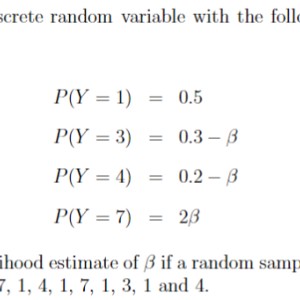Some things to note about the pmf of $Y$, it must be the case that it sums up to 1 and that all of the options have non-negative probabilities. Therefore, $\beta$ takes on a value between $0$ and $0.2$ to ensure that $P(Y=4)$ remains non-negative.
To find the maximum likelihood estimate of $\beta$, we construct the joint likelihood of these 10 observations. We are told that they are a random sample, so we assume they are independent of each other, which gives the following likelihood:
$$\mathcal{L} = \prod_{n=1}^{10} P(Y_n = y_n)$$
Where $Y_n$ and $y_n$ represent the random variable and observation of the $n$th observation, respectively. Since we are taking a product here, the order doesn't matter and we can just count up the number of observations that fall into each bucket.
We see that there are 5 observed $1$s, 1 observed $3$, 2 observed $4$s, and 2 observed $7$s comprising our 10 observations. This yields a likelihood:
$$\mathcal{L} = (0.5)^5 (0.3 - \beta)^1 (0.2 - \beta)^2 (2\beta)^2$$
Finding the maximum likelihood estimate is just going to be finding the value of $\beta$ that maximizes the above likelihood.
To clarify how we do so, we can expand this into a polynomial:
$$\mathcal{L} = -0.125 \beta ^5+0.0875 \beta ^4-0.02 \beta ^3+0.0015 \beta ^2$$
Taking the derivative of this with respect to $\beta$ is straightforward:
$$\frac{d\mathcal{L}}{d\beta} = -0.625 \beta ^4+0.35 \beta ^3-0.06 \beta ^2+0.003 \beta$$
Setting this equal to 0 and solving, we find the above 4th degree polynomial has the following four real solutions:
$$\beta = 0 \qquad \beta = 0.0883 \qquad \beta = 0.2 \qquad \beta = 0.271$$
Since we found that the solution must be in the range $\beta \in [0, 0.2]$, then we can throw out the last solution. To check the other three solutions for a max, we can just plug then in to our original likelihood and see which gives the highest value:
$$\mathcal{L} = (0.5)^5 (0.3 - \beta)^1 (0.2 - \beta)^2 (2\beta)^2$$
It should be clear from the above form that $\mathcal{L} = 0$ for $\beta = 0$ and $\beta = 0.2$. The last solution gives $\mathcal{L}(0.0883) \approx 2.6\times 10^{-6}$, since this is positive, it is our local maximum and thus our maximum likelihood estimate.
So our answer for the maximum likelihood estimate of $\beta$ is:
$$\boxed{\hat{\beta} = 0.0883}$$


